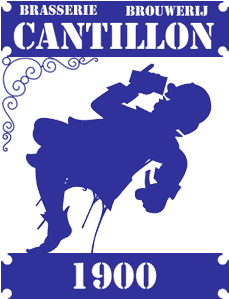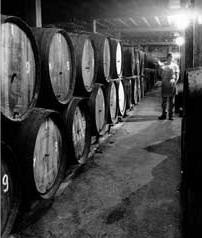 |
 |
|

|
|

|
 |
home
about
Protz
features
A-Z
books
|
|
Protz:
features
reviews
tastings
news & events
books
|

| |
Cantillon - from Belgium with love
by Willard Clarke, 01/05
I once witnessed an astonishing and possibly unique site at the Cantillon brewery in Brussels: CAMRA members refusing a second beer. It was an
open day at the brewery and the price of admission included a couple of glasses of the house beers.
But one was sufficient for people who can usually down a firkin or two of Holt's Bitter and not turn a hair. It goes to show that lambic and gueuze, the "spontaneous fermentation" beers brewed only in Brussels and the
surrounding Senne Valley region of Belgium, are not to everyone's taste.
They are challenging beers. They are mouth-puckeringly sour. They meet at a bibulous crossroads where the differences between wine, beer and cider lose all meaning.
No brewers' yeasts are allowed: nature is left to its own devices to turn malt sugars into alcohol, just as the first beers were made several millenia ago in the Old World of Babylon, Egypt and Mesopotamia.
|
|

|
Like them or loathe them, lambic and gueuze are beers of profound, historic importance. If you've never tasted them or have only come across bottled versions in Britain, why not take a short trip to Brussels via Eurostar, visit Cantillon and then sample the beer style on draught in the many fine bars the city has to offer.
Cantillon enjoys the advantage of being just five minutes' walk from Brussels Midi, the Eurostar terminus. Individuals can drop in unannounced and for a fee of �3.50 visit the brewery and enjoy a glass of beer as well. Cantillon, which proudly calls itself the Museum of Gueuze, welcomed 25,000 visitors last year, so not everyone wants to pour their beer into the nearest flower pot.
Cantillon, in the Anderlecht suburb of Brussels, dates from 1900. The present owner, Jean-Pierre Van Roy, married into the Cantillon family, took charge in 1978, and built the brewery's reputation. He is passionate about lambic and gueuze to a degree that often upsets other producers of the style. "Industrial gueuze" is not a phrase that endears Jean-Paul to his competitors but, as he nears retirement and hands over to his son, Jean, he is concerned that breweries that shorten maturation periods and use syrups rather than whole fruit in the cherry and raspberry versions of the style will lower the standing of the lambic family.

|
|
There have been some changes at Cantillon since my last visit. The brewery has had a new roof built but, in order to remain true to the faith, the replacement
has holes in it so that the wild yeast spores can enter and inoculate the sugary liquid waiting nervously, like a young bride on her wedding night, just below the eaves.
Jean-Pierre has also switched to organic production as his contribution to saving the planet. Not all the hops he uses are organic as he needs aged hops, which are hard to come by: lambic doesn't want bitterness
as it would not sit well with the sourness of the beer. Hops are aged for three years to lose their bitterness but retain their vital anti-bacterial qualities that stop lambic turning into malt vinegar. |
Jean-Pierre's support for organics stems from his concern over global warming. Lambic can only be produced in the cool months of the year as the wrong yeast spores and high temperatures interfere with fermentation during the summer and early autumn. He brews from the end of October to the end of March: "We used to brew in May, but we've lost a whole month as a result of global warming," he laments.
Jean-Pierre and Jean have also introduced a new beer called Iris that is made solely from barley malt and cannot, as a result, be called a lambic: the style is protected by Belgian law and a true lambic can only be made by a mash that is composed of a mimimum of 30% unmalted wheat, the remainder of the grain being malted barley.
In all other respects, Cantillon remains fiercely traditional. When the mash of malt and wheat has turned starch into sugar, the sweet wort is pumped to a copper and boiled with whole German hops for four to five hours. The hopped wort is then pumped to a shallow open vessel in the attic known as the cool ship.
It's left overnight when the temperature falls. Wild yeasts and other micro-flora enter through louvred windows and holes in the roof, and start the long, slow process of natural fermentation. Once fermentation is underway, the liquid is transferred to oak or chestnut casks that the Van Roys have bought from both wine and cognac makers.
Lambic -- the name probably comes from the village of Lembeek, which is still an important brewing area -- stays in cask for three years. During that period, a veritable army of yeasts and micro-flora attack the sugars in the wort. So much beer is lost through bung holes and cracks in the wood -- a loss known as the "angel's share" -- that the casks have to be regularly topped up with wort from other casks.
Gueuze is a blend of old and young lambics. One theory is that the name gueuze derives from the fact that this spritzy, lively beer gushes like a geyser when a bottle is opened. I sampled a 5% gueuze blended in 2002 from lambics made in 1999, 2000, and 2001. It was sour, with an almond nuttiness that is a characteristic of the style, with lemon and apple fruit and a delicious, mellow finish. An older gueuze, bottled in 1996 from a blend of 1993, 94 and 95 lambics, was softer, with an aroma and palate like slightly sour white wine with a pleasing hint of lemon fruit.
A 5% Kriek, made with cherries added to lambic, was a glorious red colour, a sour fruit aroma, fresh tart fruit in the mouth and a dry, lingering, fruity finish. Ros� de Gambrinus,
also 5%, is a lambic with the addition of raspberries from Macedonia: it has a superb aroma and palate of tart fruit, and a bone-dry and spritzy finish packed with more tangy fruit.
The sampling just got better and better. Vigneronne (6%) is lambic made with the addition of white wine grapes from Italy, picked late to concentrate the sugars. It has a delightfully grapy, soft, mellow, bitter-sweet
character, the Sauternes of the beer world. Iris (5%), the all-malt beer, hopped with Saaz, Styrians and Hallertauer, and matured for three years, is spicy, peppery, with some tart fruit in the mouth and finish. |
|

|
A recent addition is Cuve Fou'foune (5%), a traditional lambic made with the addition of apricots. It is extremely pale, dry, acidic, tart and bone dry in the finish. Jean-Pierre grinned his wolfish grin and said fou'foune means pussy in Brussels French. He's not referring to the brewery cat...
The Brewery is open 8.30am-5pm Monday-Friday; 10-5 Saturday, but is closed Sundays and public holidays. Groups must book in advance.
Brasserie Cantillon
For information about bars in Brussels see CAMRA's Good Beer Guide to Belgium and Holland, and White Beer Travels.
see also: Willard Clarke investigates the Lambic fruit beers of Lindemans
|
|
home
about
Protz
features
A-Z
books
|





